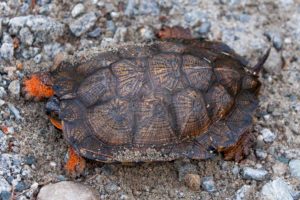Is the Atlas complete? Not yet!

Wood Turtle (Glyptemys insculpta) – an unusual species in Vermont
One of the Atlas’s priorities is to make our maps of rare species more complete. Another is to fill in remaining gaps in our records for common species. In some towns we have written reports of species but we would really like to upgrade them with photo vouchers. Also over time, some of our records need to be updated with newer reports from the same towns. You can help.
- Priorities: Rare species: we seek data on every sighting of unusual or rare species (S1, S2, and S3) in Vermont. This includes those species not listed on the Vermont Reptile and Amphibian Species List at all!
- Gaps: What’s missing? We often need a photo, and sometimes a report and a photo for even common species, such as American Bullfrogs, Eastern Newts, and Common Gartersnakes.
Take a look at the species that appear to be missing from your home town, nearby towns, or towns where you regularly spend time. Can you help us fill in these data gaps? Please grab your camera and take a friend, kids, students, Scouts, parents, and head out in search of reptiles and amphibians of Vermont.
Take only pictures, leave only footprints.
Coverage Maps: Towns that need the most effort
Click the map below to see it larger.


